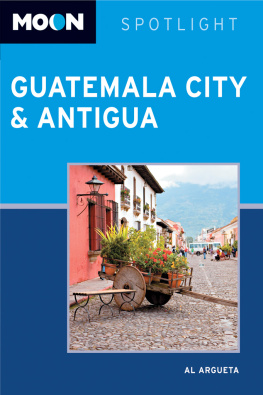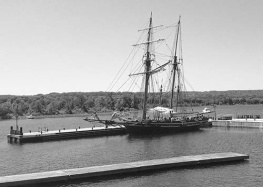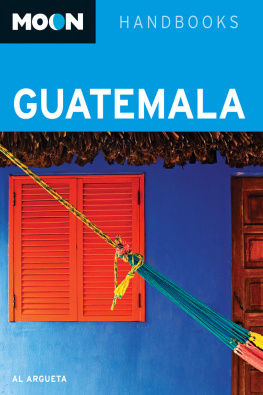You may be surprised when you first lay eyes on Guatemala City from the window of your airplane. Even if youve visited other Central American capitals, youll be taken by Guatemala Citys beauty from the air. Bordered by a lake, forested mountains, and four volcanoes, the nations capital is a bustling urban agglomeration of four million inhabitants occupying a broad valley and spilling into ravines and neighboring hillsides.
The beauty of its physical surroundings aside, Guatemala City, or Guate, as its more commonly called by locals, can seem polluted, noisy, and downright dodgy once you step onto its streetshowever, the same can be said of New York or Mexico City. Its all a matter of getting acquainted with your surroundings and discovering the pleasant aspects of this mountain city. Among these are a temperate spring-like climate, a splendid scenic backdrop, excellent dining and entertainment options, and the opportunity to travel in relative comfort with all of the amenities of a First World city.
If you give it a chance, youll find that Guate grows on you after a while. As far as Latin American capitals go, you could certainly do worse. (Some travelers find other Central American capitals less agreeable.) As the regions largest and most cosmopolitan city, Guatemala City has a wide variety of accommodations and entertainment options suited to tastes, needs, and budget.
 Palacio Nacional de la Cultura: At the heart of downtown Guatemala City, this former presidential palace now serves as a museum that offers a fascinating glimpse into the countrys rich history ().
Palacio Nacional de la Cultura: At the heart of downtown Guatemala City, this former presidential palace now serves as a museum that offers a fascinating glimpse into the countrys rich history ().
 Zona Viva: Guatemala Citys most cosmopolitan sector, while offering some of the citys best hotels, is also a fun place for a meal and a night on the town ().
Zona Viva: Guatemala Citys most cosmopolitan sector, while offering some of the citys best hotels, is also a fun place for a meal and a night on the town ().
 Museo Ixchel: The citys finest museum is a wonderful tribute to Mayan culture and to Guatemalas famous textiles and traditional village attire ().
Museo Ixchel: The citys finest museum is a wonderful tribute to Mayan culture and to Guatemalas famous textiles and traditional village attire ().
 Museo Miraflores: This excellent museum is dedicated to the ancient Mayan site of Kaminaljuy, which occupied the valley in which Guatemala City now stands. Several of the sites temple mounds lie nearby ().
Museo Miraflores: This excellent museum is dedicated to the ancient Mayan site of Kaminaljuy, which occupied the valley in which Guatemala City now stands. Several of the sites temple mounds lie nearby ().
 Museo Nacional de Arqueologa y Etnologa: Before or after visiting Guatemalas fascinating Mayan sites, head to this museum to admire many of the original pieces once found there, including beautifully carved monuments and brilliant jade masks ().
Museo Nacional de Arqueologa y Etnologa: Before or after visiting Guatemalas fascinating Mayan sites, head to this museum to admire many of the original pieces once found there, including beautifully carved monuments and brilliant jade masks ().
 Pacaya Volcano National Park: Get up close and personal with brilliant lava flows at this impressive active volcano overlooking the city and nearby Lake Amatitln ().
Pacaya Volcano National Park: Get up close and personal with brilliant lava flows at this impressive active volcano overlooking the city and nearby Lake Amatitln ().
LOOK FOR  TO FIND RECOMMENDED SIGHTS, ACTIVITIES, DINING, AND LODGING.
TO FIND RECOMMENDED SIGHTS, ACTIVITIES, DINING, AND LODGING.
The remodeled La Aurora International Airport serves as a fitting gateway to Central Americas largest city. Just minutes from the airport, youll find most of the areas frequented by Guatemalas well-to-do and foreign residents. Scattered among forest-clad ravines and sprawling east into neighboring mountainsides are Guatemala Citys business, retail, and residential sectors. The northern part of the city is home to its downtown core, which has unfortunately seen better days as a colonial capital, but is also the ongoing focus of some much-needed urban renewal. Tumbling out into surrounding ravines and plateaus in the vicinity of the downtown core are the citys slums, while its industrial sectors lie mostly to the south and west.
It should be expected that a country of such great wealth (though poorly distributed) should have a modern capital with all the First World comforts one would expect to find there. Great restaurants, museums, shops and entertainment can all be found in this cosmopolitan capital. Like everything else in Guatemala, it all coexists side by side with some of the uglier realities. Things can look very different from one zona to the next. Its all there for you to see, and nowhere else in the country is this striking contrast of wealth and poverty so evident. Look at a visit to Guatemala City as a glimpse into the countrys culture, history, and politics, and a worthy introduction to a fascinating country of contrasts with unexpected surprises around every corner.
Guatemala City is in fact the fourth capital of Guatemala, the other three having been destroyed by natural disasters, including earthquakes and mudslides, or having been replaced by the establishment of Spanish-modeled urban centers, as in the case of the first highland capital Iximch. Like Iximch, the land now occupied by the modern-day urban center was once the site of a Mayan city that exercised considerable influence over trade routes for obsidian during Classic Mayan times thanks to an alliance with the Central Mexican powerhouse of Teotihuacn. Kaminaljuy, as the city was called, was first settled sometime around 400 B.C. The early foundational cultures preceding the Mayan city established agriculture in the valley now occupied by Guatemala City and settled much of it, mostly in the western part of the valley. As with the other Classic Mayan sites, Kaminaljuy was just a distant memory by the time the Spanish arrived on the scene in the 16th century.
The citys modern settlement dates to 1776, in the aftermath of the 1773 earthquakes of Santa Marta, which rocked the previous capital, now known as La Antigua Guatemala (The Old Guatemala, or La Antigua for short). Debate over whether or not to rebuild La Antigua raged on for a few years, but in the end it was decided to start all over again in the neighboring Valle de la Ermita (Valley of the Hermitage), as the valley was known. An edict by Governor Martn Mayorga made the move official. It took a while for the new capital to catch on, as many Antigua residents refused to move despite Spanish decrees ordering the settlement of the new city. In 1800, the population of Guatemala City was only 25,000. The new city was laid out in a grid pattern, much like every other town established by the Spanish, with the construction of major public buildings including the Catedral Metropolitana (cathedral), Cabildo (Town Hall), and Palacio de los Capitanes Generales. Of these, only the cathedral remains standing.
In addition to resistance from Antigueos (residents of Antigua), the citys growth would be stifled by competition from the large highland urban center of Quetzaltenango. Indeed, it even threatened at one time to secede from Guatemala and become the capital of a new territory known as Los Altos. In the end, however, nature took care of its secessionist dreams by dealing the city a massive blow with a 1902 earthquake that left it in ruins. Though it would be reconstructed, many of the citys wealthy elite opted to move to Guatemala City. The new capital would also experience its own series of destructive earthquakes in December 1917, lasting into February of the following year. By this time, it seems, the population had come to terms with the fact that its city was built upon one of the worlds most active fault lines. The fault line would again create widespread havoc with another earthquake in 1976. Ironically, the earthquake triggered wide-scale migration into the city, resulting in the establishment of many slums lining the citys numerous ravines, or barrancos.






 Palacio Nacional de la Cultura: At the heart of downtown Guatemala City, this former presidential palace now serves as a museum that offers a fascinating glimpse into the countrys rich history ().
Palacio Nacional de la Cultura: At the heart of downtown Guatemala City, this former presidential palace now serves as a museum that offers a fascinating glimpse into the countrys rich history ().